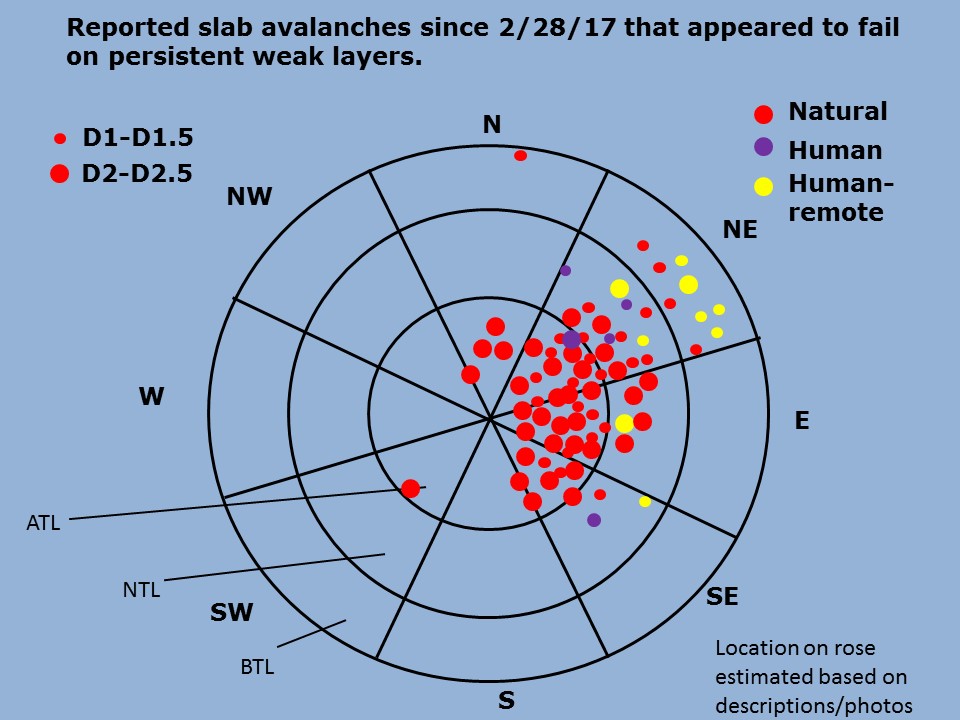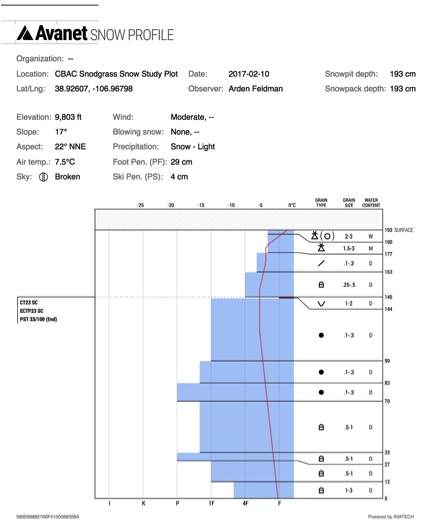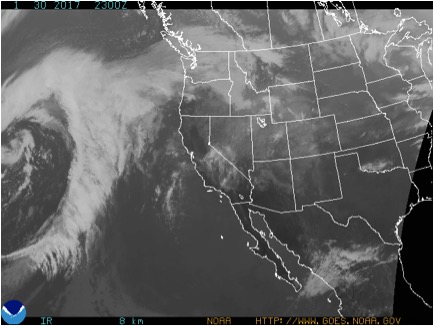February 10th – 16th: Warm Temperatures with Snow and Low Elevation Rain
By Arden Feldman CBAC Intern
The week started off balmy on February 10th with warm, moist southwest flow issuing in record high temperatures for the second day in a row. billy barr’s Gothic weather station recorded a record high of 48 degrees. A closed low off of the California coast began streaming unusually warm Pacific moisture into Colorado during the evening of the 10th. This caused increasing clouds and precipitation to filter into the region with strong winds. The freezing level was around 10,000 feet, so downtown Crested Butte and many below tree line slopes received rain, while higher elevations received dense snow. Winds on the 10th averaged 24 mph and gusted up to 89 mph at 11,000 ft. On the evening of the 11th, a cold front passed overhead sparking heavy snowfall and allowing temperatures to finally drop below freezing throughout the forecast area. By the morning of the 12th, 3” of SWE and 19” of snow had accumulated at Schofield Pass, and 14” of snow was reported at CBMR.
On the 12th, the atmospheric flow split around Colorado with the main flow to our north and the cut off low to our south. The low was still sending some leftover moisture into our area with a southerly flow, causing light snow showers.. The flow then began to dry out, beginning a clearing and warming trend through the rest of the week. On the 14th there was a high of 22F at 11,000 ft but by the 16th, there was a high of 44F with beautiful clear skies.
Persistent slabs on buried surface hoar layers on northerly and easterly aspects remained a problem this week. This week’s storm added a significant new load to the snowpack and tested the persistent weak layers, and we observed a handful of natural avalanches failing on buried surface hoar or facets again. The instabilities became increasingly isolated and stubborn through the week, but they were still present and sadly consequential, resulting in Colorado’s first fatality of the season in the Flat Tops. The storm also resulted in storm slab concerns, but few were reported likely due to the limited visibility during the storm.

2/14/17 – Persistent slab avalanche in the Flat Tops zone that resulted in the first avalanche fatality of the season in Colorado.
The warm temperatures and low elevation rain during the week resulted in wet avalanche problems. Relatively small but potentially consequential natural (here, here, here) and skier triggered wet loose avalanches were observed throughout the week, and with the rain below tree line, and several wet slab avalanches were also observed.
February 3rd – 9th: Two Windy Storms and Record Warmth
By Arden Feldman CBAC Intern
The week started off dry and warm early on the 3rd, but a weak storm impacted the area overnight into the 4th. It brought 4-5 inches of snow (.6” of SWE at Schofield Pass). Southwest winds were blowing strong during the storm with gusts up to 64 mph on the 3rd at 11,000 ft. February 5th offered a brief pause in the storminess with few clouds in the sky and temps rising to 34F at 11,000 ft.
A stronger, warm and wet winter storm began to affect our area on February 6th and lasted into the 8th. Over the course of the storm, Schofield pass picked up 1.7” of SWE and 11” of snow, Mount Crested Butte recorded 1.9” of SWE and 11” of snow, and Irwin received 20” of snow. Much of the snow consisted of graupel at lower elevations. The storm brought with it strong winds out of the west, averaging 23 mph and gusting up to 89 mph on the 7th at 11,000 ft. The storm slowly subsided during the day on the 8th and by the 9th skies were scattered and temperatures were skyrocketing. Billy Barr’s weather station in Gothic recorded a record high for the day of 47F.
The beginning of the week continued the trend of slowly stabilizing persistent slabs on the 1/19 surface hoar layer. Persistent slab instabilities were becoming increasingly isolated and stubborn, but also consequentially dense and 1-3 feet thick. On the 4th, a persistent slab on the 1/19 surface hoar layer was skier triggered in the neighboring Aspen zone.

2/4/17 – Skier triggered persistent slab avalanche running on the 1/19 surface hoar layer in the neighboring Aspen Zone.
Wind slabs on leeward aspects above tree line were added to the problem list on the 4th due to the strong winds of the first storm of the week. But with only meager storm totals during that first storm, the wind slabs remained small until the second storm of the week. These wind slabs became larger and more widespread with the second storm. Numerous natural and skier triggered (here, here, here, and here) wind slab avalanches were observed. The second concern with this loading event was increasing sensitivity of the buried surface hoar layer resulting in large persistent slab avalanches. Northerly and easterly aspects near and below tree line remained the most suspect slopes for the dangerous surface hoar layer. A few skier triggered persistent slabs on surface hoar were observed after the second storm. With the record warmth on the 9th, wet loose avalanches were added to the problem list and were observed on steep slopes around the compass, especially below tree line. A very large avalanche also ran naturally off of Gothic Mountain on the 9th.
January 27th – February 2nd: High pressure and lurking instabilities
By Arden Feldman CBAC Intern
The Elk Mountains remained under a high pressure ridge with dry, mostly clear skies and warming temperatures for the duration of the week. Cool northwesterly flow started the week off cold with strong valley inversions and clear skies. On the morning of January 27th, the temperature was down to -32F in town and -10F up at the Elkton weather station at 11,000 ft. On the 27th, winds at Elkton averaged 12 mph and gusted to 32 mph out of the northwest, transporting last week’s snow into wind slabs on leeward aspects above tree line. Similar winds continued out of the northwest until January 31st, but temperatures increased over that time. On the 31st, Elkton recorded a high of 33F and a low of 23F, while down in town there was a high of 40F and a low of -8F. These warm temperatures formed stout melt-freeze crusts on southerly aspects over the week. Flow changed to the southwest later in the week, and winds continued but were running low on snow available for transport.
Avalanche instabilities slowly stabilized over the week. Wind slabs and persistent slabs were the primary concerns. Wind slabs formed on leeward aspects during the northwest winds in the beginning of the week. Observers reported a handful of natural wind slabs running on steep, windloaded terrain at higher elevations. On the 1st, an experienced backcountry skier was caught, carried, and sustained multiple injuries after being washed over several cliffs and trees by a relatively small wind slab in consequential, westerly facing terrain above Copper Creek near Gothic
The 1/19 surface hoar continued to plague our area, with reactive persistent slabs up to several feet thick. They became harder to trigger as the week progressed, but they still lurked and avalanches on this layer were triggered almost every day of the week in either our zone or the neighboring Aspen zone. Northerly and easterly aspects near and below tree line were the most suspect slopes to contain the dangerous surface hoar layer.




























